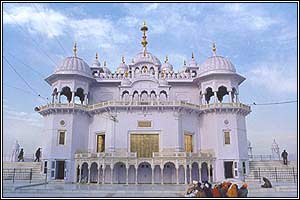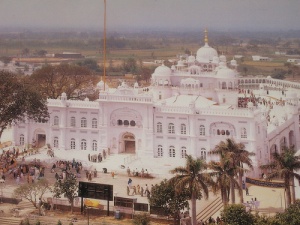Gurdwara Keshgarh Sahib
GURUDWARA SHRI KESGARH SAHIB is situated in the central place of city ANANDPUR SAHIB. It is also known as TAKHT SHRI KESGARH SAHIB. After the establishment of Anandpur Sahib, GURU GOBIND SINGH JI used to hold congregations on this hill. Revelation of Khalsa and first inititation (Khande Di Pahul) took place here. At that time the hill of KESGARH SAHIB was at least 10-15 feat higher than its present height. By the side of this hill there stood another hill. It was known as "Tambu (tent) Wali Pahari" because a special tent was set up here on the day of revelation of Khalsa. This hill does not exist any more. Similarly, there was a long range of small hills extending from Kesgarh Sahib to Anandpur fort.
KESGARH SAHIB fort was built in 1699. The hill armies attacked Anandpur Sahib several times between 1700 and 1705 but never could the invading armies reach Kesgarh Sahib because it was a very strong fort and before reaching the gates of this fort the armies had to capture the fort at Taragarh, Agamgarh, Fatehgarh and Anandgarh. This could not happen even once in the history of Anandpur Sahib. It was only on December 6,1705, when GURU SAHIB abandoned the town, the hill armies entered this fort and demolished it. The Sikhs could not enter Anandpur Sahib till Baba Banda Singh Bahadur subjugated the ruler of Bilaspur. The Sikhs had to face another wave of persecution after the fall of Baba Banda Singh.
Within the next ten years most of the Sikh homeland was under the rule of Maharaja Ranjit Singh, the Sikh Misls and the Patiala dynasty and this meant peace in the Punjab; hence Anandpur Sahib was most safe place for the Sikhs. Takht Shri Keshgarh Sahib is the main shrine at Anandpur Sahib. At Anandpur Sahib there are lying many historical Relics (Pictures in Photo Gallery) which belong to SHRI GURU GOBIND SINGH JI, Khanda (Double Edged Sword) GURU JI used to prepare amrit on the revelation of Khalsa Day. Kataar It was SHRI GURU GOBIND SINGHS personal Dagger he used to carry it with him. Saif It is double egded Weapon presented to GURU SAHIB by Mughal Empror Bahadur Shah. Gun was presented to GURU SAHIB by one of sikhs from lahore.
One of the Five Takhats or Seat of Authority of the Sikhs. This takhat is situated at Anandpur Sahib which is where Guru Gobind Singh, the tenth Guru of the Sikhs performed the first Amrit Sanchar (Initiation Ceremony) in 1699 to form the Khalsa
The other four Sikh Takhats are:
| Five Takhats Of Sikhism |
|
Shri Akal Takhat • Takhat Sri Keshgarh Sahib • Takhat Sri Patna Sahib • Takhat Sri Hazoor Sahib • Takhat Sri Damdama Sahib |
Kesgarh Sahib is the central place of Anandpur Sahib. It is also known as Takht Kesgarh Sahib. After the establishment of Anandpur Sahib, Guru Sahib used to hold congregations on this hill. Revelation of Khalsa and first inititation (Khande Di Pahul) took place here. At that time the hill of Kesgarh Sahib was at least 10-15 feat higher than its present height. By the side of this hill there stood another hill. It was known as "Tambu (tent) Wali Pahari" because a special tent was set up here on the day of revelation of Khalsa. This hill does not exist any more. Similarly, there was a long range of small hills extending from Kesgarh Sahib to Anandpur fort. In 1973, a road was constructed to link Kesgarh Sahib and Anandgarh Sahib fort and the hill-tops had to be leveled. the day of revelation of Khalsa a special congregation was held here. Thousands of Sikhs attended it. One can presume how much was the space around Kesgarh Sahib from the fact that the all the Sikhs must have seated themselves here at the time of the revelation ceremony.
Kesgarh Sahib fort was built in 1699. The hill armies attacked Anandpur Sahib several times between 1700 and 1705 but never could the invading armies reach Kesgarh Sahib because it was a very strong fort and before reaching the gates of this fort the armies had to capture the fort at Taragarh, Agamgarh, Fatehgarh and Anandgarh. This could not happen even once in the history of Anandpur Sahib. It was only on December 6,1705, when Guru Sahib abandoned the town, the hill armies entered this fort and demolished it. The Sikhs could not enter Anandpur Sahib till Baba Banda Singh Bahadur subjugated the ruler of Bilaspur. The Sikhs had to face another wave of persecution after the fall of Baba Banda Singh. But, when the Misls became the de facto rulers of the Sikh homeland, the Sikhs began making frequent visits to Anandpur Sahib. Baba Baghel Singh of Karorasinghia Misl, after the constructing Sikh shrines at Delhi, visited Anandpur Sahib in seventeen-eighties and decided to construct, repair and renovate the shrines of this town. In 1812, Mahan Chand, the ruler of Bilaspur, attacked Anandpur Sahib in order to occupy the city but suffered heavy losses.
Within the next ten years most of the Sikh homeland was under the rule of Maharaja Ranjit Singh, the Sikh Misls and the Patiala dynasty and this meant peace in the Punjab; hence Anandpur Sahib was most safe place for the Sikhs. After 1820 regular Granthis began serving at Kesgarh Sahib. Historical sources mention the names of Bhai Karam Singh, Bhai Kharak Singh, Bhai Budh Singh, Bhai Puran Singh, Bhai Amar Singh etc as the Granthis of Kesgarh Sahib. For about a century (1820 to 1925) Kesgarh Sahib had only one Granthi, but after Gurdwara reform movement (1920-25) a "Jathedar" was appointed here too. This designation was given to Giani Resham Singh, Giani Partap Singh Mallewal, Jathedar Bir Singh, Master Ajit Singh Ambalvi, Giani Fauja Singh, Giani Bachitar Singh, Jathedar Gurdial Singh Ajnoha, Jathedar Harcharan Singh Mahalon, Bhai Shawinder Singh, Bhai Balbir Singh, Bahi Manjit Singh (Prof.) etc.
Takht Sri Keshgarh Sahib is the principal shrine at Anandpur. Resplendent in its white marble glory, the shrine stands on a hillock and marks the site of the Kesgarh Fort where the historic Baisakhi congregation of 1699 had taken place. The present complex was constructed during 1936-44 under the supervision of Sant Hari Singh Kaharpuri. Being on a slope, the complex has two levels protected by retaining walls on the sides. On the lower level, approached by a flight of steps is the imposing two-storeyed gateway, offices, and a 30-metre square courtyard. The level on which stands the main building is 2.5 metres higher than the courtyard. The 16-metre square hall with a balcony in front contains within it the sanctum, a 5.5-metre square room in which some old weapons preserved as sacred relics from the time of Guru Gobind Singh are displayed on a low platform.
The Guru Granth Sahib is seated under a canopy outside the sanctum, above which rises a fluted lotus dome topped by a tall ornamental pinnacle of gilded metal, and a gilded khanda as a finial. On the roof, corners of the hall and the balcony are adorned with domed kiosks. Guru ka Langar is on the lower level behind the central building. The lower slopes of the Kesgarh hill are covered with rows of residential rooms for staff and pilgrims. This complex is collectively known as Dashmesh Nivas. A 55-metre square divan hall, about 150 metres east of the central building, was added during the 1980's to cater for large congregations on festival occasions.
A sarovaror bathing tank, 80-metre square, in a walled compound is situated at ground level to the west of the Takht Sahib and close to the Ropar-Nangal road. The relics placed in the inner sanctum of Takht Sri Kesgarh Sahib include a khanda, a katar (dagger), a saif (double-edged straight tapering sword), a muzzle-loading musket, a spear known as karpa barchha, and a nagani (a kind of spear with a twisted and pointed blade). Another set of weapons also believed to have once belonged to Guru Gobind Singh, which had been taken away by the British to England after the occupation of the Punjab in 1849 and which were returned in time for the celebration of the 300th birth anniversary of Guru Gobind Singh in 1966-67 are now on display here.


